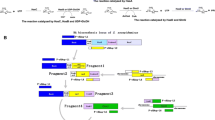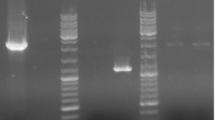Abstract
Microbial hyaluronic acid (HA), commonly produced by pathogenic Streptococcus, was made possible to be produced by a generally recognized as safe Lactococcus lactis by coexpressing HA synthase and uridine diphosphate–glucose dehydrogenase (UDP-GlcDH) of Streptococcus equi subsp. zooepidemicus in a nisin-controlled expression (NICE) system. With scarce expressed HA synthase alone, the constructed recombinant L. lactis (LL-NA) strain could produce HA with a concentration about 0.08 g/l in the M17 medium supplemented with 1% (w/v) glucose. In contrast to HA synthase, UDP-GlcDH of Streptococcus could be overexpressed in the NICE system. With coexpression of heterologous UDP-GlcDH with HA synthase, the constructed LL-NAB strain grew slightly slower to a concentration about 10% lower that of the LL-NA strain. However, the HA concentration produced was enhanced about eightfold to 0.65 g/l.




Similar content being viewed by others
References
Baker JR, Dong S, Pritchard DG (2002) The hyaluronan lyase of Streptococcus pyogens bacteriophage H4489A. Biochem J 365:317–322
Bitter T, Muir HM (1962) A modified uronic acid carbazole reaction. Anal Biochem 4:330–334
Chandrapati S, O’Sullivan DJ (1999) Nisin independent induction of nisA promoter in Lactococcus lactis during growth in lactose or galactose. FEMS Microbiol Lett 170:191–198
DeAngelis PL, Papaconstantinou J, Weigel PH (1993) Molecular cloning, identification, and sequence of the hyaluronan synthase gene from group A Streptococcus pyogenes. J Biol Chem 268:19181–19184
DeAngelis PL, Jing W, Drake RR, Achyuthan AM (1998) Identification and molecular cloning of a unique hyaluronan synthase from Pasteurella multocida. J Biol Chem 273:8454–8458
Dougherty BA, van de Rijn I (1993) Molecular characterization of hasB from an operon required for hyaluronic acid synthesis in group A Streptococci. Demonstration of UDP-glucose dehydrogenase activity. J Biol Chem 268:7118–7124
Forde A, Fitzgerald GF (2003) Molecular organization of exopolysaccharide (EPS) encoding genes on the lactococcal bacteriophage adsorption blocking plasmid, pCI658. Plasmid 49:130–142
Holo H, Nes IF (1989) High-frequency transformation, by electroporation, of Lactococcus lactis subsp. cremoris grown with glycine in osmotically stabilized media. Appl Environ Microbiol 55:3119–3123
Itano N, Kimata K (1996) Expression cloning and molecular characterization of HAS protein, a eukaryotic hyaluronan synthase. J Biol Chem 271:9875–9878
Kuipers OP, Beerthuyzen MM, de Ruyter PG, Luesink EJ, de Vos WM (1995) Autoregulation of nisin biosynthesis in Lactococcus lactis by signal transduction. J Biol Chem 270:27299–27304
Kumari K, Weigel PH (1997) Molecular cloning, expression, and characterization of the authentic hyaluronan synthase from group C Streptococcus equisimilis. J Biol Chem 272:32539–32546
Leonard BA, Woischnik M, Podbielski A (1998) Production of stabilized virulence factor-negative variants by group A streptococci during stationary phase. Infect Immun 66:3841–3847
Macrina FL, Tobian JA, Jones KR, Evans RP, Clewell DB (1982) A cloning vector able to replicate in Escherichia coli and Streptococcus sanguis. Gene 19:345–353
Mierau I, Kleerebezem M (2005) 10 years of the nisin-controlled gene expression system (NICE) in Lactococcus lactis. Appl Microbiol Biotechnol 68:705–717
O’Regan M, Martini I, Crescenzi F, De Luca C, Lansing M (1994) Molecular mechanisms and genetics of hyaluronan biosynthesis. Int J Biol Macromol 16:283–286
Sloma A, Behr R, Widner W, Tang M, Sternberg D, Brown S (2003) Methods for producing hyaluronan in a recombinant host cell. World patent application WO03/054163
Tlapak-Simmons VL, Baggenstoss BA, Clyne T, Weigel PH (1999) Purification and lipid dependence of the recombinant hyaluronan synthases from Streptococcus pyogenes and Streptococcus equisimilis. J Biol Chem 274:4239–4245
Triscott MX, van de Rijn I (1986) Solubilization of hyaluronic acid synthetic activity from streptococci and its activation with phospholipids. J Biol Chem 261:6004–6009
Widner W, Behr R, Von Dollen S, Tang M, Heu T, Sloma A, Sternberg D, DeAngelis PL, Weigel PH, Brown S (2005) Hyaluronic acid production in Bacillus subtilis. Appl Environ Microbiol 71:3747–3752
Yang PF, Lee CK (2006) Purification of recombinant hyaluronan lyase of Streptococcus pyogenes bacteriophage H4489A expressed in Escherichia coli and its application for the specific determination of hyaluronan concentration. Carbohydr Polym 65:159–164
Acknowledgment
The authors thank the National Science Consul of Taiwan for financial support (NSC 95-2221-E-011-119).
Author information
Authors and Affiliations
Corresponding author
Rights and permissions
About this article
Cite this article
Chien, LJ., Lee, CK. Hyaluronic acid production by recombinant Lactococcus lactis . Appl Microbiol Biotechnol 77, 339–346 (2007). https://doi.org/10.1007/s00253-007-1153-z
Received:
Revised:
Accepted:
Published:
Issue Date:
DOI: https://doi.org/10.1007/s00253-007-1153-z




